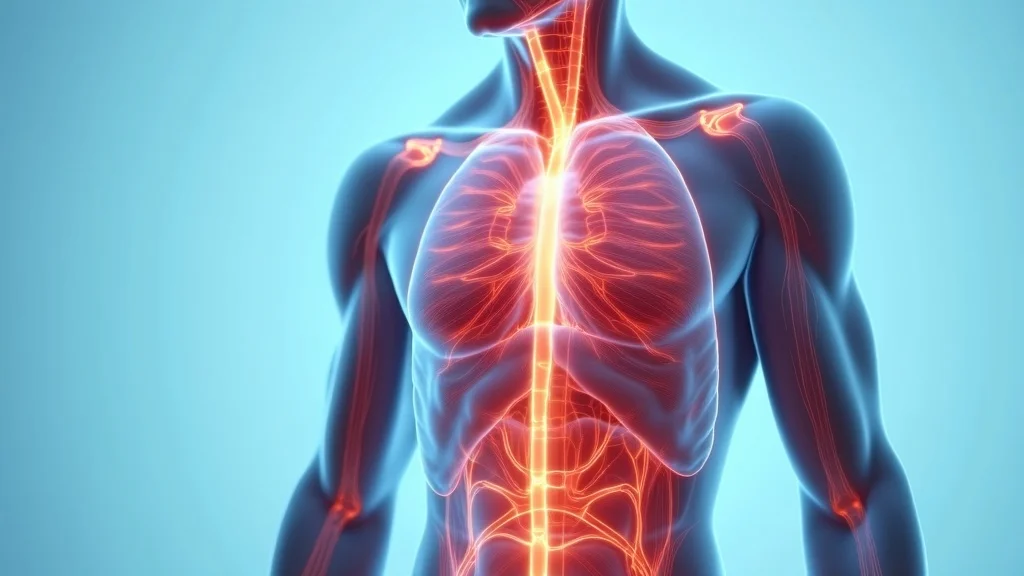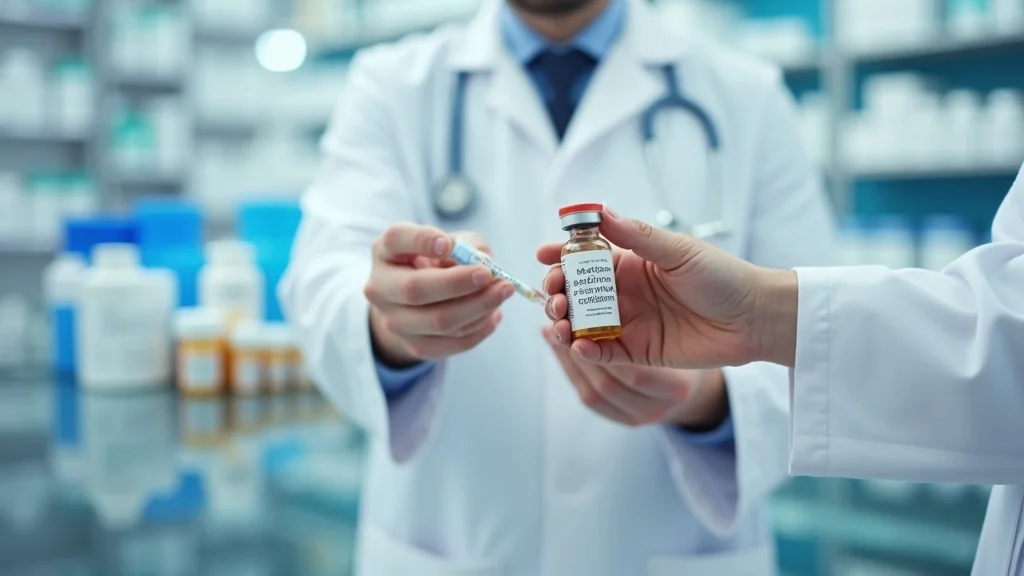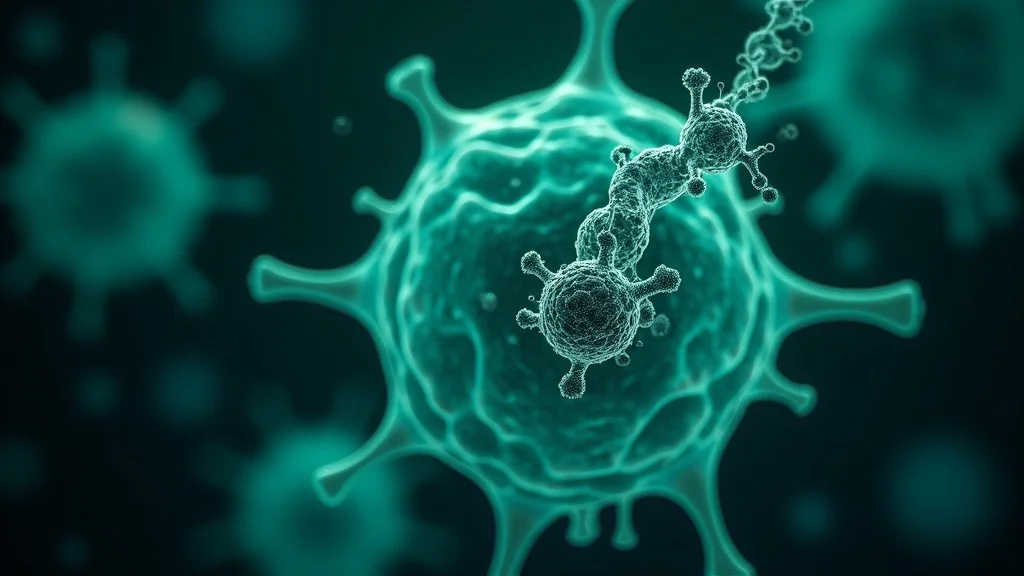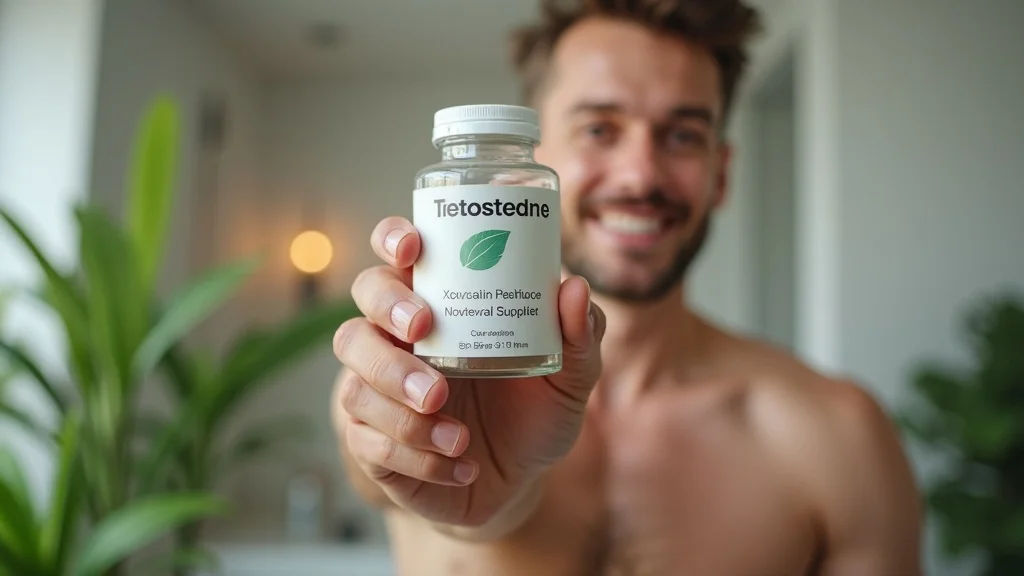Did you know that even modest increases in testosterone can lead to measurable spikes in muscle mass and body strength? For years, gym-goers and athletes have chased the elusive formula for muscle building. While testosterone and muscle growth are often discussed together, the real impact—and the safest, most sustainable ways to boost muscle—are too often misunderstood. In this article, we’ll clear the confusion, uncover the science, and help you make informed choices about building strength naturally.
A Startling Link: Surprising Facts about Testosterone and Muscle Growth
When it comes to gaining muscle mass, most people focus on intense workouts and strict diets. What’s often overlooked is the remarkable influence that testosterone has on muscle strength and lean body mass. Emerging research shows that slight elevations within the normal testosterone range can dramatically enhance your ability to increase muscle and maintain a healthy body mass. For men age 30 and above, understanding your testosterone levels is vital—especially since these levels tend to decline with each decade, directly impacting muscle performance.
The effects of testosterone extend beyond just building size; they actively affect protein synthesis, athletic performance, and even recovery times after strength training. What’s truly startling is that many men with low testosterone remain unaware, blaming fatigue, loss of muscle mass, or loss of sex drive on aging alone rather than considering a hormonal checkup or a simple blood test. Whether you’re an athlete or simply looking to stay strong as you age, understanding this link is the first step toward maximizing muscle potential safely and effectively.

Shattering Myths: Testosterone's Real Impact on Muscle Mass
For years, myths have circulated about how testosterone really affects muscle gain. Some believe only bodybuilders or steroid users benefit, while others fear unwanted side effects. The truth is, testosterone plays a fundamental role in supporting your body’s ability to grow lean muscle mass, regardless of your training level or age. Research consistently indicates that even moderate testosterone increases result in noticeable changes in both muscle strength and lean body mass—without the need for extreme doses.
It’s also a myth that synthetic testosterone replacement therapy is the only solution for men with low levels. Natural approaches, combined with tailored strength training and nutrition, can be just as effective for many people—often with fewer side effects and long-term health risks. Understanding the power and limitations of testosterone’s real impact can help you pursue muscle growth that’s both safe and sustainable.
- Testosterone levels can drop by 1-2% each year after age 30, subtly impacting muscle mass.
- Lean body mass correlates closely with circulating testosterone—low levels = higher risk of muscle loss, especially in older men.
- Naturally increasing testosterone through sleep, diet, and exercise can significantly boost muscle strength without synthetic therapy.
- Women also benefit from healthy testosterone levels in building muscle, though in lower amounts.
- Protein synthesis, the driver of muscle growth, is greatly accelerated by higher testosterone within the normal range.
“Even moderate increases in testosterone levels can result in significant changes in muscle strength and lean body mass.”
What You’ll Learn About Testosterone and Muscle Growth
This article delivers practical, science-backed information so you can decide the best way to increase muscle and maintain robust physical health. We'll explain the roles testosterone plays in muscle building, evaluate the pros and cons of replacement therapy, and reveal why natural supplements are often the smarter choice for lean body mass and muscle strength.
- The surprising science behind testosterone and protein synthesis
- How low testosterone affects body mass and muscle performance, especially in older men
- Replacement therapy vs. natural supplementation: which is safer and more effective?
- Actionable tips for supporting your testosterone levels naturally
- Frequently asked questions answered—so you make informed, healthy choices
Understanding Testosterone and Its Effects on Muscle Mass
Testosterone is more than just a “male” hormone; it’s a critical driver of lean muscle growth for both men and women. It supports not only new muscle cell development but also expedites protein synthesis, helping the body recover and adapt to strength training. Most people in the normal testosterone range enjoy better muscle repair, higher muscle mass, and improved athletic performance compared to those with low testosterone levels.
When testosterone drops—whether due to age, stress, or lifestyle—muscle growth can stagnate, and even routine activities become more challenging. Many older men first notice less muscle definition, increased fat around the waist, or joint weakness. Protecting muscle strength and maximizing body mass means proactively supporting and balancing your testosterone levels—long before symptoms occur.

How Testosterone Influences Muscle Growth and Protein Synthesis
Testosterone directly signals muscle tissue to ramp up protein synthesis. When muscles are challenged during resistance or strength training, the process of repair and rebuilding requires more protein. This is where the effects of testosterone are critical: it turns on genes that boost muscle cell growth, while also encouraging the body to use nutrients more efficiently for muscle repair, rather than storing them as fat.
Moreover, people with low testosterone levels often struggle to recover after heavy or repeated workouts. Studies show that normal or elevated testosterone can reduce post-exercise soreness and accelerate muscle growth, enabling people to train more frequently and see results faster. Ignoring this vital hormone often leads to plateaus, frustration, or even injury.
The Effects of Testosterone on Lean Body Mass and Body Mass
Maintaining optimal testosterone is essential not just for muscle, but for preserving a favorable ratio of lean body mass to fat as we age. Clinical research indicates that lean body mass tends to decline as testosterone levels decrease, especially after age 40. This can mean an increased risk of falls, poor balance, or difficulty keeping up with daily activities—issues that can affect everyone, not just athletes or older men.
On the flip side, increasing testosterone naturally helps keep both lean body mass and overall body mass in check. The natural hormone supports the development of new muscle fibers, helps preserve existing muscle, and can reduce the accumulation of stubborn body fat—particularly in the abdominal region. The result is a body that not only looks stronger but also performs better.
| Testosterone Level | Muscle Strength | Lean Body Mass |
|---|---|---|
| Low (< 300 ng/dL) | Below Average | Decreased, higher fat |
| Normal (300–800 ng/dL) | Good; supports athletic performance | Increased; optimal muscle/fat ratio |
| High (> 800 ng/dL, therapeutic) | Enhanced but increased risk of side effects | Possible lean mass gain, but not always safe |
Testosterone Levels in Older Men: Challenges and Opportunities
For older men, the natural decline of testosterone levels can sometime feel inevitable—but it’s not unavoidable. Men with low testosterone may notice less energy, reduced muscle strength, and a gradual increase in body mass or waist size. These physiological changes aren’t just about aesthetics—they’re linked to long-term health, injury risk, and quality of life.
Understanding and measuring testosterone levels becomes more important as we age. Blood tests can identify if you have symptoms of low testosterone, such as fatigue, mood shifts, or decreased sex drive, prompting you to take action early. Intervening with the right natural supplements and lifestyle changes can slow muscle loss, preserve lean body mass, and promote ongoing vitality.
How Lower Testosterone Affects Muscle Strength and Muscle Mass
Studies consistently show that lower testosterone leads to a decrease in both muscle strength and muscle size. Most men who experience a noticeable decline in muscle performance often have low testosterone as a root cause. Over time, this makes resistance training less effective, as the body simply doesn’t have enough hormonal support to build or maintain muscle mass efficiently.
This isn’t just a concern for older men; younger individuals with hormonal imbalances can experience similar difficulties. The good news? Proactive management—including exercise, proper sleep, and natural testosterone supplementation—can help reverse or prevent the loss of lean body mass and boost muscle-building potential.
- Reduced muscle strength and overall endurance
- Noticeable decrease in muscle mass, especially in arms, legs, and core
- Increase in abdominal and visceral fat
- Low energy, persistent fatigue, and slower recovery from workouts
- Diminished sex drive and mood swings

Replacement Therapy and Alternatives: Navigating Your Options
When symptoms of low testosterone become bothersome, many people consider testosterone replacement therapy (TRT). But before opting for synthetic hormones, it’s essential to weigh the potential risks and benefits—especially since natural supplementation is becoming more effective and accessible. Choosing the safest, smartest path for muscle growth and overall well-being requires understanding all your options.
While TRT can rapidly increase testosterone levels and improve muscle mass for some, it comes with a host of possible side effects—from hormonal imbalances to cardiovascular risks. In contrast, natural testosterone supplements aim to gently support your body’s own hormone production, increasing lean body mass without the same safety concerns.
The Pros and Cons of Testosterone Replacement Therapy for Muscle Growth
Testosterone replacement therapy is sometimes prescribed for clinically low testosterone levels. The benefits include speedy improvements in mood, muscle strength, and energy. However, TRT can trigger a range of undesirable effects. These include acne, headaches, fluid retention, and risk of longer-term problems like cardiovascular disease or infertility.
By contrast, natural supplementation supports hormone production rather than replacing it outright, thus minimizing side effects while still fostering muscle growth. The best approach generally starts with modifying sleep, nutrition, and exercise, then introducing targeted natural boosters. Professional advice and monitoring are always recommended.

Is Natural Testosterone Supplementation Better Than Testosterone Therapy?
The debate between synthetic TRT and natural testosterone boosters is ongoing. Clinical reviews suggest that, for most men who do not have severe hypogonadism, natural approaches are the safest and most sustainable way to maintain muscle health. Natural supplements with well-sourced, clinically tested ingredients can enhance testosterone production, support strength training gains, and improve overall body mass without overwhelming the body.
It’s also important to remember that synthetic therapy disrupts the body’s feedback mechanisms. Many users later struggle to maintain their own hormone levels and can become dependent on external treatments. The best results generally come when you empower the body to function at its best—something natural products, lifestyle, and balanced training help achieve.
“Many consumers are unaware of the potential side effects and long-term impacts of synthetic testosterone replacement.”
Exploring the Science: Protein Synthesis, Muscle Strength, and Testosterone
At the heart of muscle growth lies the process of protein synthesis—the creation of new proteins to repair and build tissues stressed by strength training. Testosterone’s role is to amplify this process, resulting in increased muscle fiber size, better muscle strength, and faster recovery. The more efficient your protein synthesis, the greater your gains in lean body mass.
Modern research demonstrates that naturally optimized testosterone levels not only trigger more muscle growth but also protect against muscle breakdown (catabolism). For anyone hoping to maximize strength improvements, understanding how testosterone works in synergy with diet and exercise is key to sustainable gains.
Testosterone’s Role in Maximizing Muscle Protein Synthesis
Testosterone acts as a molecular “switch” for protein synthesis. When levels of testosterone are in the optimal range, your body more effectively utilizes dietary protein to repair and grow muscle. This means each training session yields a higher return in both muscle size and muscle strength, especially when paired with quality nutrition and recovery.
Men and women who naturally increase their testosterone—through better sleep, stress management, and targeted supplementation—tend to see larger, faster improvements than those relying solely on training. By supporting endogenous hormone production rather than flooding the body with synthetic alternatives, you’re less likely to experience side effects or hormonal crashes.

Building Sustainable Lean Body Mass with Balanced Testosterone Levels
The ultimate goal isn’t just quick muscle gain—it’s maintaining lean body mass and strength over the long term. Balanced testosterone supports healthy bone density, keeps fat accumulation at bay, and helps regulate important metabolic pathways. Overusing synthetic therapies can lead to wild fluctuations, while natural support encourages steady, reliable results.
For those aiming for lifelong strength and vitality, regular monitoring (via blood test when necessary), comprehensive nutrition, and evidence-based supplementation provide the foundation for sustainable success.
| Approach | Muscle Growth | Side Effects | Sustainability |
|---|---|---|---|
| Natural Supplements | Gradual, steady improvement | Minimal (mostly mild or none) | Long-term, supports body’s own production |
| Synthetic TRT | Rapid but can plateau | Possible acne, headaches, cardiovascular risk | May become dependent, disrupts feedback |
People Also Ask: Your Top Questions Answered on Testosterone and Muscle Growth
Does testosterone improve muscle growth?
Answer: Current research and expert opinions on testosterone’s effects of muscle mass and strength.
Yes, robust scientific studies confirm that raising testosterone levels within the normal range increases both muscle mass and muscle strength. Testosterone amplifies protein synthesis and improves how your body responds to resistance training. Men and women with optimal levels experience greater and more consistent lean body gains, better athletic performance, and faster recovery after exercise. The caveat: excessive or artificial elevation comes with risks, so supporting your natural production is best.

Will 200mg of testosterone a week build muscle?
Answer: Insights on recommended testosterone levels, dosing for lean body mass, and safety.
A dose of 200mg testosterone per week is much higher than most doctors recommend for therapeutic replacement. While such dosages can result in fast muscle mass gain, they significantly increase the risk of side effects—like headaches, mood swings, cardiovascular strain, and hormone suppression. Experts advise that only those with medically confirmed low testosterone levels consider any therapy at this dose, and always under physician supervision. For most, lifestyle and natural supplementation yield safer, sustainable increases in muscle growth and lean body mass.
Can testosterone cause headaches?
Answer: Possible side effects of testosterone therapy and supplementation.
One of the more common side effects from starting synthetic testosterone therapy is headaches, especially during the initial periods of hormone adjustment. Other potential side effects include acne, fluid retention, sleep disturbances, and mood shifts. When using natural supplementation (with quality, clinically studied ingredients), the risk of headaches is substantially lower. Always monitor your response to any treatment and consult a healthcare provider if symptoms persist or worsen.
Can I build muscle with low testosterone?
Answer: Factors influencing muscle growth and strategies to overcome low testosterone.
Building muscle with low testosterone levels is possible but significantly more challenging. The body may not respond as effectively to training or protein intake, and results come slower. To overcome low testosterone, prioritize quality sleep, resistance training, a high-protein diet, stress management, and potentially a reputable natural testosterone supplement. If results remain limited, a blood test can clarify levels and necessary interventions.
Why Natural Testosterone Supplements Are the Better Choice
Choosing natural testosterone supplements over synthetic replacements is about more than just avoiding side effects. It’s about restoring your body’s innate hormone rhythms, encouraging long-term health, and achieving muscle growth that’s sustainable, not fleeting. Modern natural formulations can increase testosterone gently, improving muscle mass and body composition while guarding against negative health outcomes.
High-quality natural boosters use ingredients that have been clinically validated and shown to improve hormone levels, muscle strength, and overall vitality—making them the preferred option for anyone aiming to maximize physical health without unnecessary risk.

Natural Approaches to Elevate Testosterone Levels and Boost Muscle Strength
Natural interventions are the cornerstone of safe, effective muscle building. Strategies include regular strength training, optimizing sleep, reducing chronic stress, and eating a balanced diet rich in protein, healthy fats, and micronutrients such as zinc and vitamin D. These holistic actions stimulate your body’s own testosterone production and set the groundwork for muscle growth and lean body mass gains.
Adding a well-researched natural supplement can further enhance outcomes—particularly for men with low or borderline testosterone. Look for transparent labeling, clinical studies, and positive user testimonials for best results.
Evaluating Safety: Natural Supplements vs. Testosterone Replacement Therapy
Natural supplements are generally safer because they work with your body, not against it. Unlike synthetic testosterone replacement therapy, which can halt your hormone production and cause dependency or side effects, natural boosters empower your system using plant-based, mineral-rich ingredients. They’re rarely associated with severe adverse reactions, making them suitable for long-term support as part of a healthy lifestyle.
Still, not all products are created equal—the best natural supplements are supported by scientific research and contain key active ingredients (like fenugreek, ashwagandha, zinc, and magnesium) with proven benefits for testosterone and muscle mass.
- Fenugreek: Supports hormone regulation and improved muscle performance
- Ashwagandha: Reduces cortisol, aids sleep, and may boost testosterone
- Zinc: Vital for testosterone production and immune support
- Magnesium: Enhances muscle relaxation and recovery
- Vitamin D: Improves hormonal balance and bone health
FAQs: Testosterone and Muscle Growth
- How do I know if my testosterone levels are low?
- Are there natural ways to increase muscle strength for older men?
- What are the most common side effects of testosterone replacement therapy?
- Is there a risk of taking too much testosterone, even in supplement form?
- How long does it take to see results from a natural testosterone booster?
- Should women consider testosterone supplements for muscle growth?
- When should I get a blood test to check my testosterone level?
- Can lifestyle changes alone reverse low testosterone symptoms?
- What ingredients should I look for in a natural testosterone supplement?
Key Takeaways on Testosterone and Muscle Growth
- Optimal testosterone and muscle growth go hand in hand—especially for older men or those struggling to add lean body mass.
- Natural testosterone supplements support healthy hormone balance and avoid the major risks of synthetic replacement therapy.
- Diet, sleep, and resistance training remain the foundation; supplements further enhance strength, recovery, and muscle gain.
- Always consult a healthcare provider for persistent symptoms of low testosterone, and seek products with proven, safe ingredients.
Making the Informed Choice: Grow Your Muscle Mass with Testosterone the Natural Way
It’s never too late to reclaim your physical strength and vitality. By understanding the true relationship between testosterone and muscle growth, you empower yourself to make smart, sustainable choices that prioritize long-term health—without risking harmful side effects.

Final Thoughts: The Long-Term Benefits of Natural Testosterone and Muscle Growth
Choosing a natural approach now means more energy, improved muscle mass, and a stronger, healthier you for years to come.
 Add Row
Add Row  Add
Add 




Write A Comment